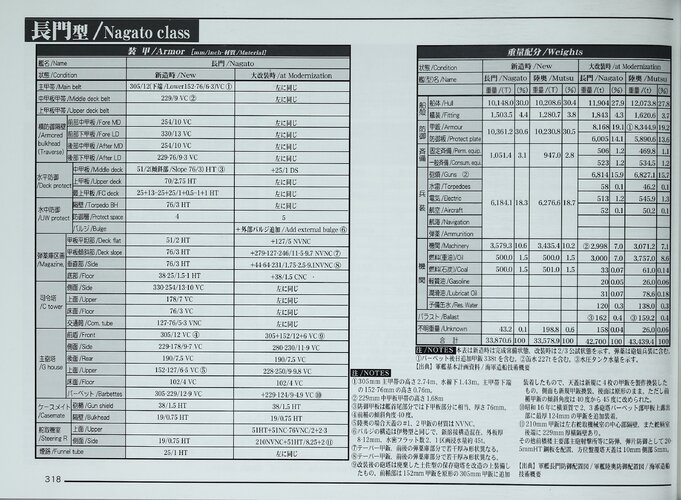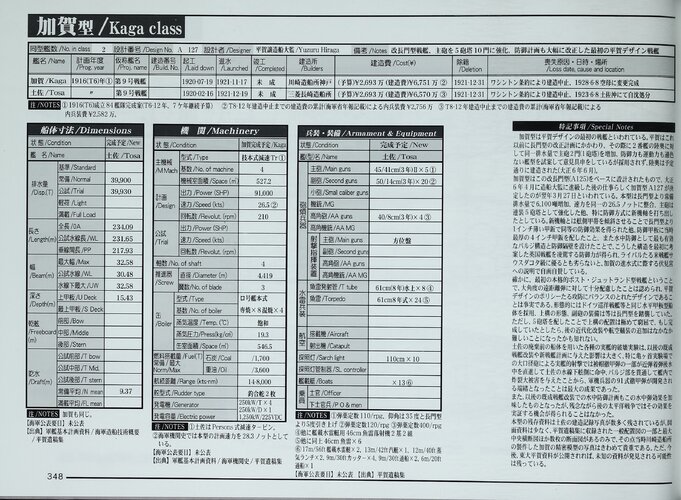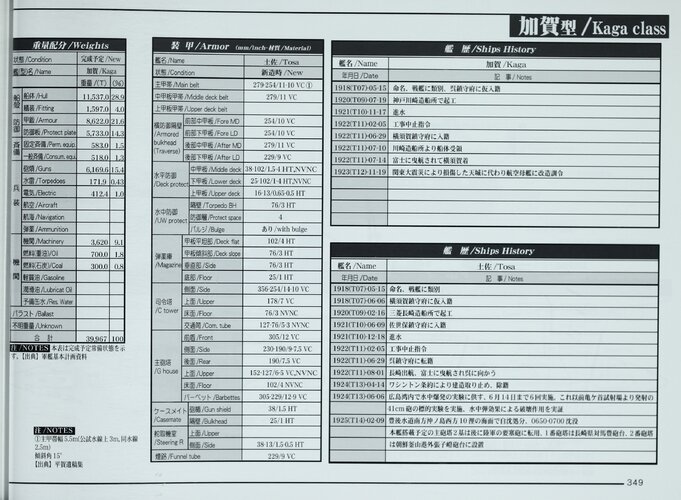- Joined
- 1 February 2011
- Messages
- 2,802
- Reaction score
- 3,166
Part I: The British Ancestry
The design history of the Japanese Nagato class battleships, the world's first and fastest 16"/410mm armed battleships is long, and only partially documented. The sentence being the Nagato class not only the first indeginiously designed Japanese Battleship or the first Battleship entirely designed by Yuzuru Hiraga is not accurate. Before the first known Japanese design: A-102 which could be connected to the Nagato class in 1915/16 was born, the famous British ship building firm Vickers offered four proposals to the Imperial Japanese Navy in 1913 armed with 16" cannons: Designs 646,646A,647 and 647A. Designs 646 and 647 were 16"/40 while the "A" sub variants were 16"/44 armed proposals. Norman Friedman briefly mentions these offers with some info on dimensions and armament: 4 twin 16" turrets, 16x 6" secondary guns, 8 submerged torpedo tubes and other guns as on the Kongo eg 16x 3" guns. Other noteworthy feature the relative high speed of these proposals, outmatching any battleships of the time and reaching the same values as the first generation battlecruisers like the Invincible class.
It is very likely that these proposals heavily influenced the creation of the Nagato class battleships, both in size, speed and armament!
Vickers Design 646
Norman Friedman mentions and provides some data for this proposal in his book: The British Battleship 1906-1946. As a basis for the drawing I've chosen a modified and lengthened Queen Elizabeth class battleship with some alterations on the bridge and mainmasts as well as of course 16" armed turrets.

 www.deviantart.com
www.deviantart.com

The design had the following characteristics:
Dimensions: 184,4 (pp) x 28,65 x 8,7 meters
Displacement: 29.000tons (standard)
Armour: 305mm Belt
Engines: Unknown, likely 68.000shp
Speed: Unknown, likely 44-46km/h (24-25knots)
Armaments:
4x2 406mm/40 (16"/40) Vickers Mark A Cannons,
16x1 152mm/50 (6"/50) Vickers Mark S Guns,
16x1 76mm/40 (3"/40) Vickers Mark N Guns,
8x1 533mm Underwater Torpedo Tubes
Vickers Design 646A
Design 646A was a slight modification of the baseline design 646 using 406mm/44 cannons (16"/44) rather the shorter /40 calibre one. This difference in main weaponry together associated with a somewhat different turret carrying them resulted a net increase in displacement by 800tons to 29.800tons. For this design to not look like a longer barrelled Design 646 I've repositioned the mainmast, moving it just behind the 3rd turret as well as changing the main crane's facing and modelled the turrets after that used on HMS Hood: Mark II, previously I've used a somewhat enlarged turret of the Queen Elizabeth class eg the Mark I turrets and arranged the 3" Guns somewhat differently placing more on the main deck level.

 www.deviantart.com
www.deviantart.com

The design had the following characteristics:
Dimensions: 184,4 (pp) x 28,65 x 8,7 meters
Displacement: 29.800tons (standard)
Armour: 305mm Belt
Engines: Unknown, likely 69.000shp
Speed: Unknown, likely 44-46km/h (24-25knots)
Armaments:
4x2 406mm/44 (16"/44) Vickers Mark A Cannons,
16x1 152mm/50 (6"/50) Vickers Mark S Guns,
16x1 76mm/40 (3"/40) Vickers Mark N Guns,
8x1 533mm Underwater Torpedo Tubes
Vickers Design 647
After the 646/646A designs that Vickers offered for Japan another pair was offered, this time with an added length of 4,5 meters likely to better achieve higher speeds and a net increase of 500tons, otherwise it has the same armament and armour as 646.

 www.deviantart.com
www.deviantart.com

The design had the following characteristics:
Dimensions: 188,98 (pp) x 28,65 x 8,7 meters
Displacement: 29.500tons (standard)
Armour: 305mm Belt
Engines: 68.5000shp
Speed: 48km/h (26knots)
Armaments:
4x2 406mm/40 (16"/40) Vickers Mark A Cannons,
16x1 152mm/50 (6"/50) Vickers Mark S Guns,
16x1 76mm/40 (3"/40) Vickers Mark N Guns,
8x1 533mm Underwater Torpedo Tubes
Vickers Design 647A
Like how the previously mentioned Design 646A was a slightly modified version of 646, the same applies to design 647A a modification of the baseline 647 variant
The changes are: longer calibre /44 cannons rather /40 ones, extra 1.250tons of displacement and 1.500shp more power to offset this extra tonnage.

 www.deviantart.com
www.deviantart.com

The design had the following characteristics:
Dimensions: 188,98 (pp) x 28,65 x 8,7 meters
Displacement: 30.750tons (standard)
Armour: 305mm Belt
Engines: 70.0000shp
Speed: 48km/h (26knots)
Armaments:
4x2 406mm/44 (16"/44) Vickers Mark A Cannons,
16x1 152mm/50 (6"/50) Vickers Mark S Guns,
16x1 76mm/40 (3"/40) Vickers Mark N Guns,
8x1 533mm Underwater Torpedo Tubes
The design history of the Japanese Nagato class battleships, the world's first and fastest 16"/410mm armed battleships is long, and only partially documented. The sentence being the Nagato class not only the first indeginiously designed Japanese Battleship or the first Battleship entirely designed by Yuzuru Hiraga is not accurate. Before the first known Japanese design: A-102 which could be connected to the Nagato class in 1915/16 was born, the famous British ship building firm Vickers offered four proposals to the Imperial Japanese Navy in 1913 armed with 16" cannons: Designs 646,646A,647 and 647A. Designs 646 and 647 were 16"/40 while the "A" sub variants were 16"/44 armed proposals. Norman Friedman briefly mentions these offers with some info on dimensions and armament: 4 twin 16" turrets, 16x 6" secondary guns, 8 submerged torpedo tubes and other guns as on the Kongo eg 16x 3" guns. Other noteworthy feature the relative high speed of these proposals, outmatching any battleships of the time and reaching the same values as the first generation battlecruisers like the Invincible class.
It is very likely that these proposals heavily influenced the creation of the Nagato class battleships, both in size, speed and armament!
Vickers Design 646
Norman Friedman mentions and provides some data for this proposal in his book: The British Battleship 1906-1946. As a basis for the drawing I've chosen a modified and lengthened Queen Elizabeth class battleship with some alterations on the bridge and mainmasts as well as of course 16" armed turrets.

Vickers Export Design 646 by Tzoli on DeviantArt

The design had the following characteristics:
Dimensions: 184,4 (pp) x 28,65 x 8,7 meters
Displacement: 29.000tons (standard)
Armour: 305mm Belt
Engines: Unknown, likely 68.000shp
Speed: Unknown, likely 44-46km/h (24-25knots)
Armaments:
4x2 406mm/40 (16"/40) Vickers Mark A Cannons,
16x1 152mm/50 (6"/50) Vickers Mark S Guns,
16x1 76mm/40 (3"/40) Vickers Mark N Guns,
8x1 533mm Underwater Torpedo Tubes
Vickers Design 646A
Design 646A was a slight modification of the baseline design 646 using 406mm/44 cannons (16"/44) rather the shorter /40 calibre one. This difference in main weaponry together associated with a somewhat different turret carrying them resulted a net increase in displacement by 800tons to 29.800tons. For this design to not look like a longer barrelled Design 646 I've repositioned the mainmast, moving it just behind the 3rd turret as well as changing the main crane's facing and modelled the turrets after that used on HMS Hood: Mark II, previously I've used a somewhat enlarged turret of the Queen Elizabeth class eg the Mark I turrets and arranged the 3" Guns somewhat differently placing more on the main deck level.

Vickers Export Design 646A by Tzoli on DeviantArt

The design had the following characteristics:
Dimensions: 184,4 (pp) x 28,65 x 8,7 meters
Displacement: 29.800tons (standard)
Armour: 305mm Belt
Engines: Unknown, likely 69.000shp
Speed: Unknown, likely 44-46km/h (24-25knots)
Armaments:
4x2 406mm/44 (16"/44) Vickers Mark A Cannons,
16x1 152mm/50 (6"/50) Vickers Mark S Guns,
16x1 76mm/40 (3"/40) Vickers Mark N Guns,
8x1 533mm Underwater Torpedo Tubes
Vickers Design 647
After the 646/646A designs that Vickers offered for Japan another pair was offered, this time with an added length of 4,5 meters likely to better achieve higher speeds and a net increase of 500tons, otherwise it has the same armament and armour as 646.

Vickers Export Design 647 by Tzoli on DeviantArt

The design had the following characteristics:
Dimensions: 188,98 (pp) x 28,65 x 8,7 meters
Displacement: 29.500tons (standard)
Armour: 305mm Belt
Engines: 68.5000shp
Speed: 48km/h (26knots)
Armaments:
4x2 406mm/40 (16"/40) Vickers Mark A Cannons,
16x1 152mm/50 (6"/50) Vickers Mark S Guns,
16x1 76mm/40 (3"/40) Vickers Mark N Guns,
8x1 533mm Underwater Torpedo Tubes
Vickers Design 647A
Like how the previously mentioned Design 646A was a slightly modified version of 646, the same applies to design 647A a modification of the baseline 647 variant
The changes are: longer calibre /44 cannons rather /40 ones, extra 1.250tons of displacement and 1.500shp more power to offset this extra tonnage.

Vickers Export Design 647A by Tzoli on DeviantArt

The design had the following characteristics:
Dimensions: 188,98 (pp) x 28,65 x 8,7 meters
Displacement: 30.750tons (standard)
Armour: 305mm Belt
Engines: 70.0000shp
Speed: 48km/h (26knots)
Armaments:
4x2 406mm/44 (16"/44) Vickers Mark A Cannons,
16x1 152mm/50 (6"/50) Vickers Mark S Guns,
16x1 76mm/40 (3"/40) Vickers Mark N Guns,
8x1 533mm Underwater Torpedo Tubes

































